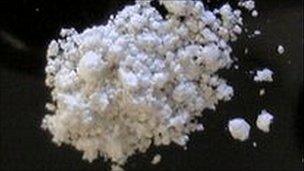'Legal highs' created at an 'unprecedented pace'
- Published

The drugs are developed by people who examine scientific literature about drug compounds
A record number of new "legal highs" were reported across Europe in 2010, with four times as many found in the UK than any other country, figures show.
The European Monitoring Centre for Drugs and Drug Addiction said there were 41 new substances, external, of which 16 were first reported in the UK.
The drugs were appearing at an "unprecedented pace", as 24 were found in 2009 and 13 in 2008, it said.
The UK is introducing legislation to temporarily ban untested drugs.
The monitoring centre, which records drugs use across the continent, said 2010 saw the largest number of new substances ever reported across Europe in a single year.
The list includes synthetic cannabinoids, synthetic cathinones and synthetic derivatives of well-established drugs. Their names include MDAI, iso-ethcathinone, 4-MBC and DMAA.
A further 15 derivatives of the compound on which banned drug mephedrone is based, cathinone, were detected during the year, and two from ketamine.
Experts say the drugs are developed by people who examine scientific literature about drug compounds.
Legally-sourced chemicals
If these are banned they develop a legal variant which then gets manufactured, often in China, and then sold in the UK as drugs.
Not all of these drugs are banned under UK law.
The UK government is introducing legislation to temporarily ban new "legal highs" until they are proven to be medically safe by the Advisory Council on the Misuse of Drugs (ACMD).
A Home Office spokesman said the government was "committed to tackling emerging new drugs and stopping them gaining a foothold in this country".
"We have among the most effective systems in Europe for identifying new psychoactive substances," he said.
"Just because a drug is advertised as legal does not mean that it is either legal or safe."
Drugs advice charity Drugscope said there was now an "ever greater interaction between the illicit and non-illicit pharmaceutical markets", with legally-sourced chemicals being sold as replacements for illicit psychoactive substances.
Toxic to humans
"The make-up of these new substances may bear little relation to a user's expectations," said chief executive Martin Barnes.
"Head shops (outlets selling drug paraphernalia) and online sellers, often buying in large batches from overseas, cannot be certain what they are purchasing and selling on."
Dr John Ramsey, head of drugs database unit TicTac Communications at St George's University of London, said the drugs presented a major public health risk.
"The core of the problem is that none of these drugs have been properly tested to see how toxic they are to humans. If they will cause long-term health problems such as cancer or birth defects, would we know about that?"
He said he feared the government's plan for deferred legislation would not work, as the ACMD would not have the resources to do risk assessments for the number of substances which were emerging each year.
"What we have got to do is stop kids from buying them. Would you buy a research compound from an iffy website for £30 and take it? Quite how we change this I don't know, but there is always going to be something new on the market."
The European monitoring centre's director, Wolfgang Gotz, said that "given the speed at which new developments occur in this area" it was important to anticipate emerging threats.
He said: "This could be addressed by actively purchasing, synthesising and studying new compounds and by improving our capacity for investigative forensic analysis and research at European level."
- Published17 August 2010